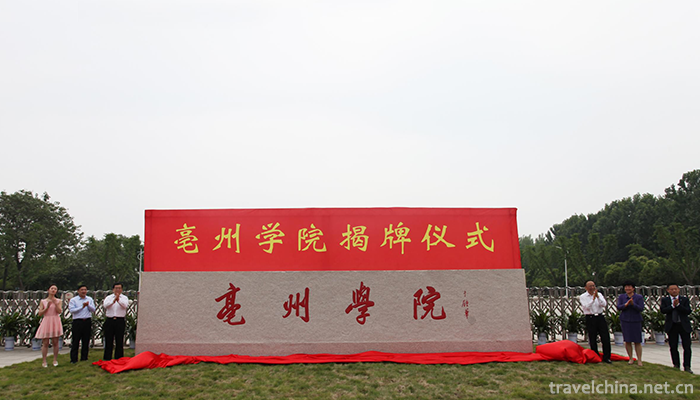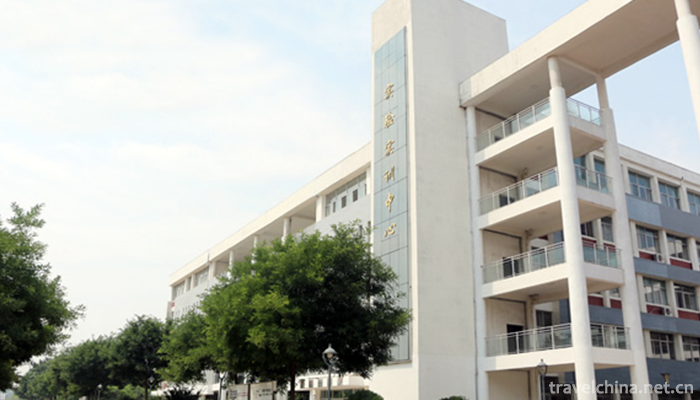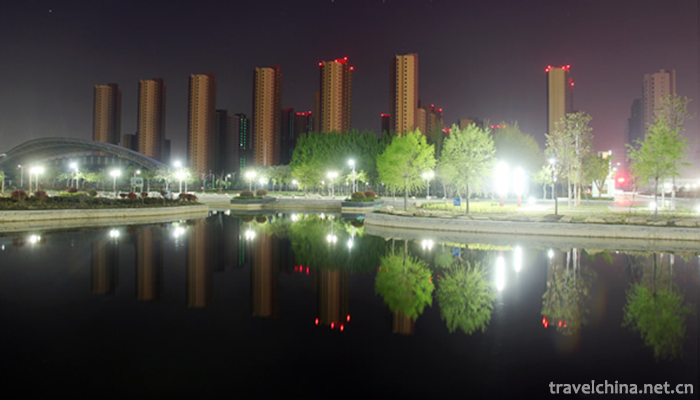Bozhou University
Bozhou College (Bozhou University), for short, is located in Bo Yuan. Anhui Province Bozhou City By the state Ministry of Education Approved full-time full-time undergraduate institutions.
Qing Dynasty Xuan Tong In the first year (1909), Zhang Tingyang was in February. Temple of Ci Founded the Mengcheng Teacher Training Institute; in 1952, completed the Mengcheng normal school; in 2002, it was upgraded to Bozhou Teachers College In March 22, 2016, it was approved by the Ministry of education and upgraded to an ordinary undergraduate college in Bozhou.
As of June 2019, the school covers an area of 925 mu, with a building area of 253 thousand square meters, a total of 7000 yuan of teaching equipment and 600 million yuan of fixed assets. collection There are 630 thousand books. There are 11 teaching faculty departments. They have 22 undergraduate majors and 34 specialist specialties. There are 417 full-time teachers and nearly 8000 students.
Historical evolution
· Before the founding of new China
Qing Dynasty Xuan Tong In the first year (1909), Zhang Tingyang was in February. Temple of Ci The establishment of the Mengcheng teachers' Institute.
In 1916, Mengcheng County County Magistrate Wang Chi Run Mengcheng normal school.
In 1929, Mengcheng County opened a teacher training institution, one year of schooling, and training primary school teachers.
In 1933, the Mengcheng county middle school was equipped with a simplified teacher training class to cultivate 50 primary school teachers.
In 1943, two Jian Jian teachers were set up for 4 years.
November 1948, due to Huaihai Campaign The flames of war spread and stopped.
· Anhui Mengcheng normal school
In 1952, Mengcheng County Junior Normal School was set up for the county. Wanfo pagoda The paramount temple is the three small courtyard in Chengguan today.
In September 1953, the school moved to the south gate from the city.
In July 1956, the "Mengcheng Junior Normal School" was renamed "Mengcheng Normal School of Anhui province".
In 1978, the English class was set up to strengthen the construction of English education major.
In 1980, Mengcheng normal school was designated as the provincial key school by the provincial government.
In 1991, it was approved as a primary school teacher training center in Fuyang.
In 1990, it was approved as United Nations Children's Fund Teacher training project school.
In 1991, the assessment of education departments at all levels was passed. The State Education Commission commended that the basic education was to train qualified teachers, with clear direction and remarkable achievements.
In 1996, it was examined and evaluated by the State Education Commission.
In 1999, he passed the comprehensive evaluation of education and teaching in Anhui Province, and was awarded the title of "excellent teacher training school in Guangdong Province". At the same time, it was designated as the Pilot School of five year system for primary and secondary school enrollment.
· Bozhou Teachers College
In October 2000, Anhui Provincial People's Government Approval of Anhui Mengcheng normal school upgraded to Bozhou Teachers College 。
In 2001, the first high school starting three year college enrollment.
In March 2002, approved by the Ministry of education, it was upgraded to a public normal college.
In 2010, Bozhou Preschool Normal School Incorporated into Bozhou Teachers College.
In 2011, Bozhou preschool normal school ran independently. From September 1st onwards, the school as a whole Mengcheng County Move to Bozhou Qiaocheng District 。
· Bozhou College
In March 22, 2016, the Ministry of Education approved Bozhou Teachers College to be upgraded to Bozhou college.
In May 20, 2016, the Bozhou College held the inauguration ceremony.
Scale of running a school
Establishment of departments
According to the official website of the school in June 2019, the school covers an area of 925 Mu and nearly 8000 students. The Department of Chinese medicine, Department of electronics and information engineering, Department of biology and food engineering, Department of economics and management, Department of education, Department of Chinese and media, Department of foreign languages, fine arts, music department, Department of physical education, Marx school and so on are 11 teaching departments. It has 22 undergraduate and 34 specialties. In 2017, 6 new undergraduate programs in Bozhou college were Bioengineering (brewing direction), pharmaceutical engineering, electronic information engineering, Chinese language and literature, economy and finance, sports rehabilitation.
Faculty strength
According to the official website of the school in June 2019, there were 417 full-time teachers, including 53 professors, 106 associate professors and 46 Ph. D. teachers. Among full-time teachers, there are 152 postgraduate teachers (17 PhD). There are 1 excellent teachers in the country, 6 teachers at the provincial level, 5 at the provincial level, 7 at the provincial level, 4 at the municipal level, 4 at the provincial level.
National Excellent Teachers Li Jinze
Provincial Teaching Masters (Higher Vocational) Zhang Lichi Zhang Liang Wang Yumin, Wang Fucheng, Li Ying, Liu Zheng Zhang Huifang
Provincial Education show (Higher Vocational) Cao Shuai and Kang Yu Wang Yong, Xu Jianzhong Xie Dong
Provincial Teaching Team (Higher Vocational) : teaching team of Pharmaceutical Engineering (responsible person: Ouyang Wenzhu), teaching team of Ideological and Political Theory Course (person in charge: Wang Zhengming) The teaching team of the integrated English Course (responsible person: Wang Yong) and the teaching team of Higher Mathematics (head: Tang Shuqiao)
Teaching construction
· quality engineering
According to the official website of the school in August 2016, the school has 2 central financial support construction specialties, 8 provincial featured specialties, 5 provincial comprehensive reform pilot programs, 7 provincial top quality courses, 3 provincial level demonstration experimental training centers, 3 provincial school enterprise cooperation practical education bases, 2 provincial level outstanding talents education and training programs, and 2 provincial university student innovation laboratory construction plans.
Central finance supports professional development (Higher Vocational) Biotechnology, application and Mathematics Education
Provincial specialty (Higher Vocational) Tourism services and management, logistics management, fine chemicals production technology, pre school education, language education, and mathematics education. Electronic information engineering technology, business English
Provincial Comprehensive Pilot Reform (Higher Vocational) : accounting computerization Elementary education and fine arts education Biotechnology, application and computer application technology
Provincial Demonstration Experiment Training Center (Higher Vocational) : Teachers' teaching skills training center, chemical engineering training center. Psychological Experiment Center
Provincial school enterprise cooperation practical education base (Higher Vocational) : Pharmaceutical Analysis and cooperation base of Hua Tuo, Chinese medicine, school and enterprise, and Practical Education Center for Biotechnology talents. Logistics engineering school enterprise cooperation practical education base
Provincial excellent talent education and training plan (Higher Vocational) : Excellent Pharmaceutical Analysis Technician Technician program Excellent liquor brewing technician training program
Provincial Quality Course (Higher Vocational) Introduction to Bo culture, economic law, comprehensive English, primary English teaching method, ideological and moral cultivation and legal basis. Analytic geometry, teacher writing skills
Provincial university student laboratory construction program (Higher Vocational) "Xue Zhong Fei" creates customer space and creates dream space for dream students.
· Teaching achievement
As of June 2016, school students awarded more than 420 people in national and provincial disciplines and skills competitions. In 2010 -2012, the school won the first prize of provincial teaching achievement 1 and three awards 8.
Cooperation and communication
· School enterprise cooperation
According to the official website of the school in August 2016, schools and Northward Canton , Changjiang Delta A total of more than 40 well-known enterprises in the Republic of China signed a cooperation agreement, setting up 36 practical training bases in the enterprises, and building more than 150 experimental and training centers in schools and enterprises. Set up biotechnology and application (ancient well class), fine chemicals production technology (ancient well class), pharmaceutical analysis technology (Hua Tuo medicine class), biopharmaceutical technology (Hua Tuo medicine class), pharmaceutical preparation technology (Hua Tuo medicine class).
· External communication
According to the official website of the school in June 2019, schools have extensively carried out cooperation between schools, schools, enterprises, schools and schools, and set up a platform for cooperation in production, teaching and research, to carry out collaborative innovation, to promote integration of production, teaching and research, to promote integration of work and study, to integrate production and teaching, and to create a platform for integrating practice, training, employment and integration. The Institute has established friendly cooperation with Philippines La Salle University, Thailand Bo Ren University, Han Han Na University, South Korea's song University, Taiwan Yuan Pei Medical University of science and technology, Taiwan min Hui medical and nursing management school, Lithuania Vilnius University and so on. The Institute is cooperating with more than 30 enterprises such as Beijing Oracle Corp, Beijing International Education Group, Shanghai Changshuo group, Guangdong Anton logistics, and so on, to carry out a substantial order type talent training, and cooperate with local well-known enterprises such as Gujing Group, Hua Tuo Guo Yao and Guang Yin Tang Pharmaceutical Company.
academic research
scientific research institution
According to the official website of the school in August 2016, the Institute has established research institutes such as basic education research institute, cultural tourism research institute, Gujing Culture Research Institute, Bioengineering Institute, Bozhou intelligent industry and Internet of things Technology Research Institute, Bo an traditional Chinese medicine daily chemical research institute, Chinese Medicine Culture Research Institute, green color energy technology and Applied Research Institute and so on. Set up Fudan University The Bozhou branch of the New Rural Development Research Institute, established the Bo Culture Research Center, established the Bozhou five animal show research base, and the Bozhou two clip string research center.
Achievements in scientific research
From 2014 to 2015, faculty members obtained 62 patent numbers.
As of July 2015, the Bo Culture Research Center has successfully declared 20 provincial and ministerial level projects, published over 100 papers in over three academic journals, and published more than 10 academic monograph.
In 2015, 4 key projects of Humanities and Social Sciences in universities and colleges in Anhui were obtained, 3 key items in natural science research at provincial level, 1 items in provincial philosophy and Social Sciences, 2 in general projects, 2 in municipal scientific research projects, and 10 in horizontal projects. A total of 566 thousand yuan was awarded for scientific research.
In 2016, there were 8 key projects in Humanities and Social Sciences in Anhui, 1 items in major projects, 3 key items in natural science research in Universities in Anhui, and 1 items in National Humanities tasks. A total of 510 thousand yuan was awarded for scientific research.
Academic resources
· Collection resources
According to the school's official website in August 2016, schools collection There are more than 63 books, 839 kinds of Chinese and foreign periodicals, and nearly 620 thousand copies of e-books. Purchase CNKI China HowNet There are 23 Chinese and foreign language databases: the general database of China's tool book network publication, the ancient book database of Hantang collection, the Zhengbao multimedia database, the TKBS normal education special database, the Taiwan Huayi academic literature database, the local chronicle database resources and so on.
The school library collaborated with the online reporting hall, the nine feather digital library, the non Book Information Center, the superstar e-book and the Anhui university resource sharing platform.
· Academic journals
The academic research of Bozhou college is the director of the Education Department of Anhui province and the comprehensive research sponsored by Bozhou Teachers College.
Joint Academic Journal. It was first published in the 2003 quarterly.
There are standing columns such as Bo culture studies, political and legal studies, philosophy and social studies, literature and language studies, basic education and pre-school education, higher vocational education research, etc.
In 2005, he was awarded the excellent journal of Anhui province. In 2013, the column of "Bo culture research" was awarded the provincial "characteristic column Award" in the quality monitoring and evaluation of the whole province's newspapers and periodicals.
Cultural tradition
School badge
The school badge is composed of the seal character "Bo", the peony flower, the handwriting "Bozhou College", the English school name and the 1909.
The combination of elements. The word "Bo" represents the ancient history and culture of Bozhou. The background of Bozhou flower and peony flower shows the local characteristics of Bozhou. The name of the handwritten book is strong and vigorous. The name of the English school is of equal linear font. 1909 represents the long history of running a school. The logo is concise and clear, with deep historical connotation and strong local characteristics, and is easy to identify and disseminated.
Interpretation of "Bo": Bo, dedicated to place names, now Anhui Province Bozhou City 。 "Bo" as Emperor and Cheng Tang The capital city has a history of about 4600 years. The word "Bo" has a long history. Analytical Dictionary of Characters "Said" Jing Zhao, Du (Club) "Ting Ting, also from the high Province, Torr (read Zhe) sound. The pavilion of Jing and Du is a shrine for the country. The tortois is a primitive plant with a vertical spike, representing the five grains of general reference. Bo is the symbol of Shang's establishment of the state. It is the capital of Shang Cheng Tang, the place where the Yin people worship the ancestral temple. It represents the Shang Dynasty's family and has a profound meaning. It can understand the long history and culture of Chinese characters from the characters.
School motto
Be good at learning and teaching
In university education, we should combine learning with thinking and combine knowledge with practice. Shan Xueshan's dogma is sticking to it.
Focusing on talent cultivation, teachers and students should foster lifelong learning beliefs, foster lifelong learning ability, and jointly improve the scientific and humanistic quality of teachers and students. The process of teaching and learning, teachers' interaction with teachers and students, knowledge exploration and the pursuit of life significance and value can be realized by teachers' rigorous study and students' learning. " The way of University In Ming Ming De, in the people, in the best. " School education is the foundation of educating people and moral education is the first. The purpose of educating oneself is to persist in the first place of moral education, and to promote teachers and students to be virtuous, virtuous, and virtuous. Teachers follow the rules of higher education and the rule of students' growth, teach and educate people, "build up themselves independently", consciously cultivate themselves, and learn to be upright and upright. Students consciously and self disciplined, learn from their own teachers, and have both ability and integrity. Teachers and students encourage each other and make progress together.
Teaching style
Preciseness, norm, truth-seeking and extension
Style of study
Diligent, thoughtful, inspiring and enterprising
http://www.bzuu.edu.cn/



0 Questions
Ask a Question
Your email address will not be published.